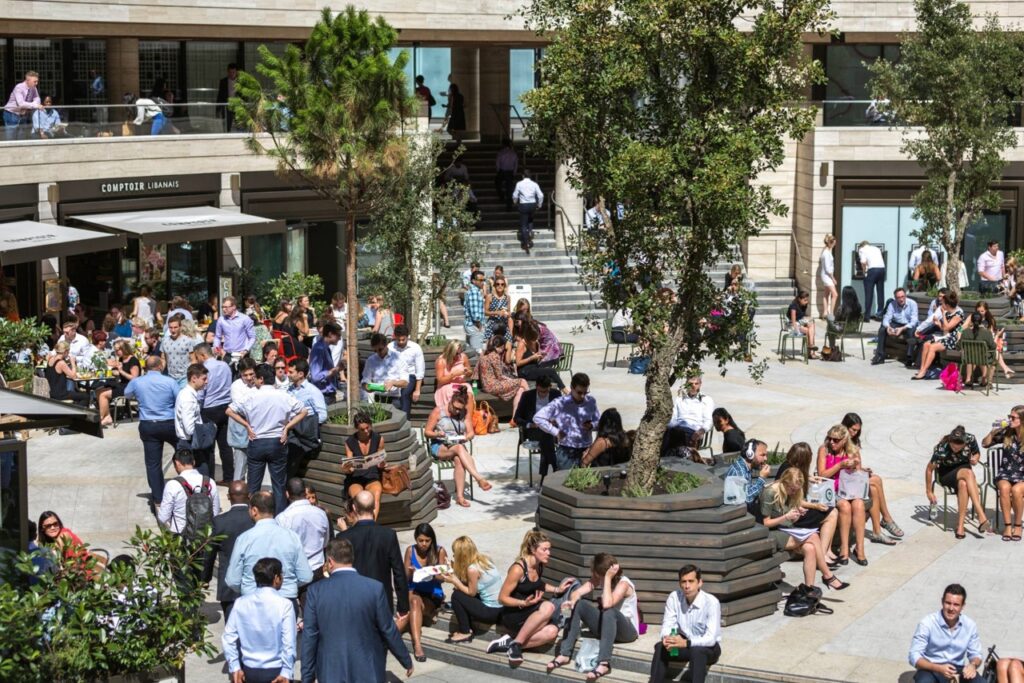Placemaking is a powerful tool that can amplify the dynamics of knowledge communities and innovation districts. If used with greater sophistication and understanding, placemaking can drive intentional interactions, build diverse knowledge communities, and ignite innovation.
Proximity is not Enough – Attracting your Audiences
Innovation Districts and campuses of various kinds are built on the premise of proximity. If you pack diverse smart people into the same intentional community, they’ll bump into each other, exchange ideas, and the result will be innovation. Imagine doctors and scientists having coffee together and talking about work: once in a while there will be a thunderbolt of revelation and the scientist will invent a new gadget that solves a medical problem. Or the doctor will casually drop a vital tidbit that is the missing piece for a scientific riddle.
However, innovation districts aren’t always so good at making those serendipitous meetings happen. There may be a rich mix of talented people populating their buildings, but only a flimsy fabric that weaves them together. Effective placemaking in knowledge communities hinges on a deep understanding of its potential user groups and audiences. The ability to discern the needs, preferences, and aspirations of the individuals in the community is paramount.
Think of the doctors and scientists in this example as two species of birds: let’s say sparrows and blackbirds. If we want both bird types in our yard we have to scatter the food that will attract each, to the same location at the same time. Sparrows are seed-eaters and they also like breadcrumbs; blackbirds are fruit-lovers, partial to apples, pears, and berries. There’s a rational formula involved in getting these birds to meet and mingle.
People are more nuanced, but the principle is the same: if we sprinkle the right ingredients – programming, amenities, food of the right type and price point – we can maximize the proximity principle to enable the interactions we always intended.
However, this discussion advocates for a placemaking strategy that elevates this concept. By meticulously curating environments and experiences that seamlessly align with the unique needs and interests of diverse members of knowledge communities, we enhance the potential for interactions that genuinely foster innovation.
This level of placemaking necessitates a tailored approach, carefully designed to accommodate the unique characteristics, interests, and motivations of these community members. Such an audience-centric approach ensures that diverse groups not only coexist but also derive genuine value from their interactions, transforming the innovation district from concept to reality.
Crafting Tailored Environments and Programs
The transformative potential of placemaking within innovation districts, or “communities of innovation,” becomes apparent when we consider the imperative of environments and programs that are bespoke—intentionally designed to bring specific audiences together. In addition to unique seed mixes comprising programming, amenities, food and beverage, we need to think about behavior settings as well. Grounded in environmental psychology, the notion of behavior settings elaborates on the idea that specific environments inherently foster distinct activities and behaviors. Back to our bird analogy, sparrows and blackbirds need more than food: we need to accommodate behaviors like sheltering from weather, bathing, nesting, etc. So, we need a birdbath, a combination of open spaces, dense vegetation, and perching spots. Creating a diverse habitat with various niches can encourage different species to coexist.
By designing behavior settings uniquely tailored to the members of a knowledge community, placemaking can succeed at fostering intentional interactions. Each community is different, but examples might include bars and cafes, indoor/outdoor workspaces, recreation and entertainment offerings, green restorative environments, places for family members, such as playgrounds and dog runs.
Intentional Communities need Intentional Placemaking
Some might call this level of stratagem a form of social engineering. But knowledge communities, being inherently intentional, demand a deliberate and thoughtful approach. This involves recognizing the importance of purposefully bringing together individuals from diverse backgrounds and fields. By adeptly applying the techniques and theories outlined above, we navigate this intentionality with finesse and integrity.
At the core of innovation districts is the belief that innovation increases by virtue of the many opportunities for serendipitous encounters in the district (my collaborator Stephen Coulston describes this characteristic as “bumpability”). Placemaking should be used to fulfill this vision by orchestrating spaces that make interactions less serendipitous and more mindful. As placemakers and designers, we have exciting opportunities to nurture environments that connect individuals and give them settings in which to collaborate, innovate, and unwind.


